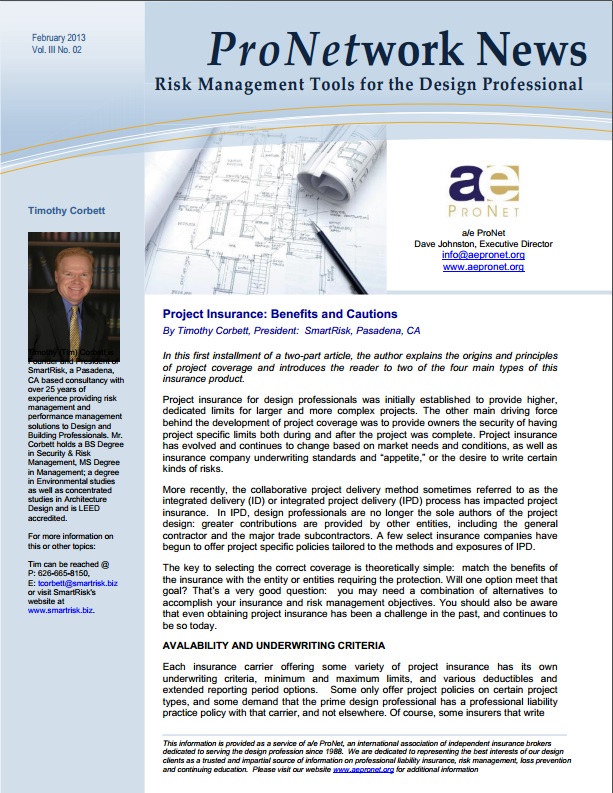 The February 2013 issue of ProNetwork News is the first installment of a two-part article; the author, Tim Corbett of SmartRisk explains the origins and principles of project coverage and introduces the reader to two of the four main types of Project Insurance.
The February 2013 issue of ProNetwork News is the first installment of a two-part article; the author, Tim Corbett of SmartRisk explains the origins and principles of project coverage and introduces the reader to two of the four main types of Project Insurance.
Project insurance for design professionals was initially established to provide higher, dedicated limits for larger and more complex projects. The other main driving force behind the development of project coverage was to provide owners the security of having project specific limits both during and after the project was complete. Project insurance has evolved and continues to change based on market needs and conditions, as well as insurance company underwriting standards and “appetite,” or the desire to write certain kinds of risks.
More recently, the collaborative project delivery method sometimes referred to as the integrated delivery (ID) or integrated project delivery (IPD) process has impacted project insurance. In IPD, design professionals are no longer the sole authors of the project design: greater contributions are provided by other entities, including the general contractor and the major trade subcontractors. A few select insurance companies have begun to offer project specific policies tailored to the methods and exposures of IPD.
The key to selecting the correct coverage is theoretically simple: match the benefits of the insurance with the entity or entities requiring the protection. Will one option meet that goal? That’s a very good question: you may need a combination of alternatives to accomplish your insurance and risk management objectives. You should also be aware that even obtaining project insurance has been a challenge in the past, and continues to be so today.
AVAILABILITY AND UNDERWRITING CRITERIA
Each insurance carrier offering some variety of project insurance has its own underwriting criteria, minimum and maximum limits, and various deductibles and extended reporting period options. Some only offer project policies on certain project types, and some demand that the prime design professional has a professional liability practice policy with that carrier, and not elsewhere. Of course, some insurers that write
design professional practice liability do not offer project coverage at all.
The following information is typically required by carriers in developing a project specific coverage quote:
- Name, location and complete description of the project
- Name and address of the project’s prime professional
- Description of the design team’s experience with similar types of projects
- Design team’s loss history
- Names and addresses of all the design sub-consultants
- Total estimated construction values and professional fees
- Duration of design and construction phases, and
- Limit of liability and deductible desired
BASIC TYPES OF PROJECT INSURANCE
There are four basic options for project insurance available today:
- Project Professional Liability Insurance
- IPD Project Specific Insurance
- Project Specific Insurance Limits
- Owner Controlled Insurance Policies
To examine the first two types in turn, and discuss their benefits, typical features and cautionary points, download the full PDF version of the newsletter here. Part 2, covering Project Specific Insurance Limits and Owner Controlled Insurance Policies, will be released publicly at the beginning of next month, so be sure to subscribe to the blog via email or follow a/e ProNet on Twitter for the alert!
About the Author: Timothy (Tim) Corbett is Founder and President of SmartRisk, a Pasadena, CA based consultancy with over 25 years of experience providing risk management and performance management solutions to Design and Building Professionals. Mr. Corbett holds a BS Degree in Security & Risk Management, MS Degree in Management; a degree in Environmental studies as well as concentrated studies in Architecture Design and is LEED accredited. For more information on this or other topics, visit the SmartRisk website or email Tim at tcorbett@smartrisk.biz.



